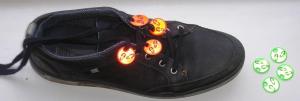Hi-viz shoelace reflector discs issued by school travel planners to encourage children to walk to school
Wearing hi-viz apparel in the UK probably started on the railways in the 1960s. So that train drivers and track workers could see each other from further away, the fronts of trains were painted yellow, and the workers donned hi-viz jackets. In the following decades it gradually spread – first to traffic policemen, then to all the emergency services, then to other outdoor workers.
Some individual cyclists and motorcyclists thought it must be a good idea, and it wasn’t long before schools started using it when moving a group of child pedestrians around.
Now, they’re doing it for pets and even chickens as well as shoelace reflectors fro school kids.Compulsory use of hi-viz is already a reality for many workers and children. One of us has been required to wear hi-viz when visiting towpath surfacing works, presumably so that digger drivers could see me better. There’s a real possibility that hi-viz could become compulsory for cyclists .
The obvious questions that arise – or rather, the questions that should be asked, are:
– What is the evidence that wearing hi-viz is a sensible precaution, and in what circumstances?
– What are the consequences of use of hi-viz for those who don’t wear it?
And finally,
– In a culture which accepts hi-viz wearing as normal and desirable, what is the effect on the safety and well-being of cyclists and pedestrians generally?
On railways, there’s a clear benefit from being seen as far away as possible. Trains take a long time to stop, and drivers normally don’t expect people on the track. And lack of sharp bends means that drivers can see to a point where you might be visible in hi-viz and invisible without it. The same can apply on motorways – drivers aren’t expecting pedestrians, are going fast, and have long sightlines.
(Note: The key element here is what drivers expect.)
But what about ordinary roads – such as a bending A-road with a 50 or 60 mph limit? Sometimes sightlines are long, but often they will be shortened by sharp bends. Lights can sometimes be seen round bends at night, but hi-viz can’t – day or night. So hi-viz is a poor substitute for lights in this situation. The only safe way is for drivers to be able to stop in the space they can see to be clear. The most basic rule of safe driving, in the Highway Code and elsewhere, is to “Never drive in such a way that you cannot stop within visible distance“.
At town driving speeds, drivers can stop within 10 metres. Are there any circumstances under which you would be visible in hi-viz and invisible without, when that close? Does it help (bends permitting) to be seen 50 or 100 metres away in this situation? By definition the motor vehicle that collides with you is rather close
Cyclists have questions to answer too. “Being seen” is not just a question of the driver seeing you because they have been actively working to do see you – or to put it another way, watching out for you – but you putting yourself in a position where they are more likely to do so. Hence the emphasis on taking the correct position in modern assertive cycle training
In a 2012 paper, (Miller, P (2012) The use of conspicuity aids by cyclists and the risk of crashes involving other road users: a population based case-control study. Miller tried to analyse the actual effect on cyclist casualties of wearing or not wearing hi-vis. To the surprise of many, he found that there was no statistically significant benefit – in fact he measured a non-significant disbenefit, after controlling for all the factors he could. The study was a case-control study, and therefore very susceptible to confounding factors, especially as riders who choose to wear hi-viz are likely to be more risk-averse than those who don’t. This would tend to reduce the apparent risk of cycling wearing hi-viz as against not wearing it, but this wasn’t found.
So it’s far from clear that there’s any safety benefit to cyclists from wearing hi-viz in urban areas, where most collisions happen.
What are the consequences of use of hi-viz for those who don’t wear it?
As the fashion for hi-viz has spread, is it far-fetched to suggest that this will have adverse effects on those who don’t use it? It is surely a reasonable hypothesis that drivers become used to seeing cyclists and pedestrians as people who are going to be wearing bright clothing and/or hi-viz will become less likely to watch out for and therefore see those who don’t. The big losers here will be pedestrians, as smaller proportions of walkers will volunteer to wear hi-viz for what is still seen (so far) as a normal, non-hazardous activity.
People, as readers of this blog should now know, adapt to what is around them.
In a culture which accepts hi-viz wearing as normal and desirable, what is the effect on the safety and well-being of cyclists and pedestrians generally?
We now deal with the longer term effects of this move. There limited resources in a society which can be used to address safety issues. A significant part of this effort – both through formal “road safety” agencies and in everyday culture – is to instruct those potential victims of road danger to think of themselves as at least partly responsible for being hit by a motor vehicle if they are not wearing hi-viz. We would suggest that this, along with other trends to place the burden of responsibility away from the source of danger on the road to those at particular risk from it.
Previously we have argued that this fashion needs to be seen in its political dimension (small “p” for the power relationship between different road user groups). Does it not make sense to suggest that this fashion feeds into and exacerbates the classis excuse of SMIDSY (Sorry Mate, I Didn’t See You)?
A precaution
A “road safety” message from the nice people at BMW Education
If
- There is limited, minimal, zero or negative evidence for the short-term benefits of wearing hi-viz clothing when walking or cycling
- There is the possibility that, as hi-viz wearing spreads, people carrying on their daily business using benign modes of transport – which should be seen as mainstream and normal – are possibly more at risk if they do not wear hi-viz
- It seems sensible to suggest that the dominant culture will increase the shift of responsibility away from those who should be primarily held accountable for collisions
Does it not seem a sensible precaution to view the advocacy and wearing of hi-viz as indeed a victim-blaming red herring and part of the problem of danger on the roads?
(This post is by Dr. Robert Davis and Colin McKenzie)


Here’s my long screed on the topic of “defensive walking” in the context of child pedestrian safety from a California perspective.
http://www.cyclelicio.us/2013/defensive-walking-california-senate-agenda/
This attitude also has the effect that the only positive action the Police take to improve ‘safety’ for cyclists is to pursue and harangue cyclists without lights. No policing of ASLs, stopping cars who pass bikes too close etc. Not to mention the annual ‘the clocks are going back so we must get cyclists to have lights and hi-viz’ stream of letters and articles in the local press…
http://www.bournemouthecho.co.uk/archive/2013/10/25/10763697._Be_bright_and_be_seen__cyclists_warned/
Pingback: The Tour de France is welcomed to South Yorkshire – with this “road safety” rubbish | Road Danger Reduction Forum
There has been quite a lot of discussion here in Aus as to the effectiveness of Hi Vis for cyclists. In my opinion, the public is now too used to it for it to prevent injury. Unfortunately wearing Hi Vis myself whilst cycling hasn’t diminished the chances of nearly being run off the road. Tammy
Pingback: Cycling Campaign Releases Briefing Note on Minimum Passing Distance Proposals | Galway Cycling Campaign
Pingback: Kids in Hi-Viz – safety or smothering? | ClassHug